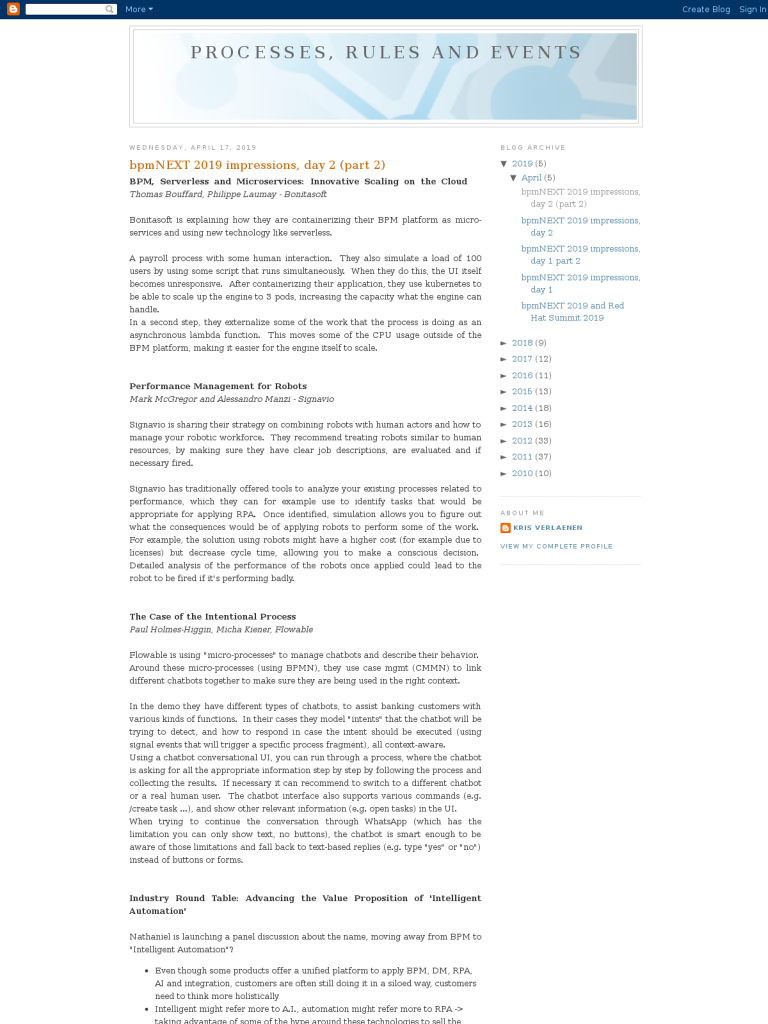BPM, Serverless and Microservices: Innovative Scaling on the Cloud Thomas Bouffard, Philippe Laumay – Bonitasoft
Bonitasoft is explaining how they are containerizing their BPM platform as micro-services and using new technology like serverless.
A payroll process with some human interaction. They also simulate a load of 100 users by using some script that runs simultaneously. When they do this, the UI itself becomes unresponsive. After containerizing their application, they use kubernetes to be able to scale up the engine to 3 pods, increasing the capacity what the engine can handle.
In a second step, they externalize some of the work that the process is doing as an asynchronous lambda function. This moves some of the CPU usage outside of the BPM platform, making it easier for the engine itself to scale.
Performance Management for Robots
Mark McGregor and Alessandro Manzi – Signavio
Signavio is sharing their strategy on combining robots with human actors and how to manage your robotic workforce. They recommend treating robots similar to human resources, by making sure they have clear job descriptions, are evaluated and if necessary fired.
Signavio has traditionally offered tools to analyze your existing processes related to performance, which they can for example use to identify tasks that would be appropriate for applying RPA. Once identified, simulation allows you to figure out what the consequences would be of applying robots to perform some of the work. For example, the solution using robots might have a higher cost (for example due to licenses) but decrease cycle time, allowing you to make a conscious decision. Detailed analysis of the performance of the robots once applied could lead to the robot to be fired if it’s performing badly.
The Case of the Intentional Process
Paul Holmes-Higgin, Micha Kiener, Flowable
Flowable is using “micro-processes” to manage chatbots and describe their behavior. Around these micro-processes (using BPMN), they use case mgmt (CMMN) to link different chatbots together to make sure they are being used in the right context.
In the demo they have different types of chatbots, to assist banking customers with various kinds of functions. In their cases they model “intents” that the chatbot will be trying to detect, and how to respond in case the intent should be executed (using signal events that will trigger a specific process fragment), all context-aware.
Using a chatbot conversational UI, you can run through a process, where the chatbot is asking for all the appropriate information step by step by following the process and collecting the results. If necessary it can recommend to switch to a different chatbot or a real human user. The chatbot interface also supports various commands (e.g. /create task …), and show other relevant information (e.g. open tasks) in the UI.
When trying to continue the conversation through WhatsApp (which has the limitation you can only show text, no buttons), the chatbot is smart enough to be aware of those limitations and fall back to text-based replies (e.g. type “yes” or “no”) instead of buttons or forms.
Industry Round Table: Advancing the Value Proposition of ‘Intelligent Automation’
Nathaniel is launching a panel discussion about the name, moving away from BPM to “Intelligent Automation”?
- Even though some products offer a unified platform to apply BPM, DM, RPA, AI and integration, customers are often still doing it in a siloed way, customers need to think more holistically
- Intelligent might refer more to A.I., automation might refer more to RPA -> taking advantage of some of the hype around these technologies to sell the porfolio.
- We might be selling BPM technology, but we might be marketing more a vision that is broader than that.
- BPM is not just technology, it’s a methodology
- Intelligent Process Automation?
- workflow or orchestration is becoming more popular again (for the technology) but is less marketable
- What are we doing?
- Technology to help by automating some of the work
- “Free the humans”
That concludes the second day, half a day left tomorrow, where I will be presenting myself.








